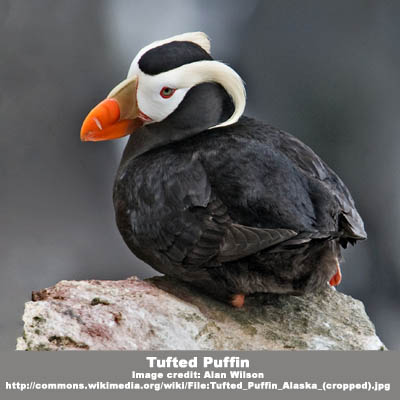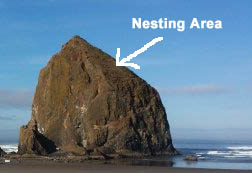Can You Spot The Puffins?
Puffins On Haystack Rock
Tufted Puffins return to Haystack Rock every April and typically stay thought July. The move into burrows on the NW face of the rock and raise a single "puffling."

Tufted Puffins are about 14 inches in length and weight about 1-1/2 pounds. They have short wings that are about as wide as the length of their body (14 inches). The have a thick orange bill, a mostly black body with a white facial patch. At the beginning of the summer reproductive season they develop yellow tufts, and that's why they are called tufted puffins.
With their short wings Tufted Puffins are not capable of gliding in the air, but they are excellent for diving and swimming underwater.
Why do Tufted Puffins like Haystack Rock?
Tufted Puffins prefer small, isolated islands that provide protection from predators while also being close to sources of food. The select islands with high areas that allow then to take to the air successfully. The ideal habitat also provides relatively soft soil and grass in which they can create burrows. Haystack Rock provides the perfect high, steep slopes that Tufted Puffins love. It's the perfect home for a Tufted Puffin.
Spotting Tufted Puffins
Tufted Puffins can be difficult to spot while flying. They basically look like a black football.

Look for Tufted Puffins on the upper slope on the NW side of The Rock. (See the picture to the right.) You should be able to see the birds sitting on the The Rock, landing and taking off.
Other Birds on the Rock
Another common bird on Haystack Rock is the Pelagic Cormorant (aka Baird's cormorant) that builds nests made from grass and seaweed on narrow ledges on the south side of The Rock. Look for them as they are drying their outstretched wings after diving for fish. Pelagic Cormorants are greenish-black in color and are larger than Tufted Puffins with a boy that is 24 to 36 inches in length.
Of course, the most common bird you'll see are seagulls. These are Western Gulls. Adults are are white with gray wing feathers, an a yellow bill. You'll often see juveniles (under four years old) that are grayish in color.
Other birds you might spot include the pigeon-sized Pigeon Guillemot (very rare); the Black Oystercatcher, Harlequin Ducks, and at times you might spot a Bald Eagle or Peregrine Falcon praying on the other birds.
